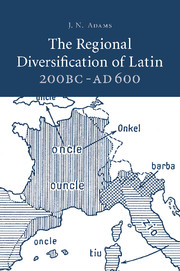Book contents
- Frontmatter
- Contents
- List of maps
- Preface
- List of abbreviations
- Chapter I Introduction
- Chapter II The Republic: inscriptions
- Chapter III Explicit evidence for regional variation: the Republic
- Chapter IV Explicit evidence: the Empire
- Chapter V Regionalisms in provincial texts: Gaul
- Chapter VI Spain
- Chapter VII Italy
- Chapter VIII Africa
- Chapter IX Britain
- Chapter X Inscriptions
- Chapter XI Conclusion
- Maps
- Bibliography
- Index verborum
- Subject index
- Index locorum
Chapter II - The Republic: inscriptions
Published online by Cambridge University Press: 22 September 2009
- Frontmatter
- Contents
- List of maps
- Preface
- List of abbreviations
- Chapter I Introduction
- Chapter II The Republic: inscriptions
- Chapter III Explicit evidence for regional variation: the Republic
- Chapter IV Explicit evidence: the Empire
- Chapter V Regionalisms in provincial texts: Gaul
- Chapter VI Spain
- Chapter VII Italy
- Chapter VIII Africa
- Chapter IX Britain
- Chapter X Inscriptions
- Chapter XI Conclusion
- Maps
- Bibliography
- Index verborum
- Subject index
- Index locorum
Summary
INTRODUCTION
It has been said that as many as forty languages or language varieties have been identified in Italy of the period before Rome spread its power over the whole peninsula. Problems of definition and identification are considerable, but the linguistic diversity of republican Italy was on any account marked. Latin, spoken originally in the small area of Latium Vetus, which contained Rome, was just one of numerous languages. The first traces of habitation at the site of Rome date from the end of the Bronze Age (c. 1000 BC), and these communities ‘were similar to other hilltop settlements that have been identified throughout Latium Vetus, whose cemeteries provide evidence of a distinct form of material culture known as the cultura laziale’ (T. J. Cornell, OCD3, 1322). The people of Latium Vetus are generally known as the Latini, who from ‘very early times … formed a unified and self-conscious ethnic group with a common name (the nomen Latinum), a common sentiment, and a common language’ (Cornell, OCD3, 820). The Latin that they spoke begins to turn up in fragmentary form around 600 BC, but it is not until the end of the third century BC that literary texts appear. Already in the plays of Plautus, however, there are represented numerous registers which show that, even if writing had had little place in Latin culture hitherto, the language had evolved a considerable variety, with different styles appropriate to different circumstances already well established.
- Type
- Chapter
- Information
- The Regional Diversification of Latin 200 BC - AD 600 , pp. 37 - 113Publisher: Cambridge University PressPrint publication year: 2007



